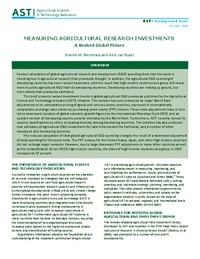Authors:
Beintema, Nienke; Stads, Gert-Jan
Year:
2008
Publisher
International Food Policy Research Institute (IFPRI); and Agricultural Science & Technology Indicators (ASTI)
Back to:
Revised calculations of global agricultural research and development (R&D) spending show that the world is investing less in agricultural research than previously thought. In addition, the agricultural R&D spending of developing countries has been revised downward, with the result that high-income countries as a group still invest more in public agricultural R&D than do developing countries. Developing countries are making up ground, but more slowly than previously estimated.
This brief presents revised investment trends in global agricultural R&D previously published by the Agricultural Science and Technology Indicators (ASTI) initiative. This revision has been prompted by major World Bank adjustments to its comparative pricing of goods and services across countries, expressed in internationally comparable exchange rates known as purchasing power parity (PPP) indexes. These index adjustments have in turn led to downward revisions of global economic growth figures by the International Monetary Fund (IMF), and an upward revision of developing-country poverty estimates by the World Bank. Furthermore, ASTI recently revised its country classifications to reflect increasing diversity among developing countries. The initiative has also produced new estimates of agricultural R&D investments for Latin America and the Caribbean, and a number of other developed and developing countries.
The reduced calculation of total global agricultural R&D spending is largely the result of a downward adjustment of total spending for China and India. The PPP indexes for the United States, Japan, and other high-income countries did not undergo major revisions. However, due to large downward PPP adjustments in many other countries as well as the reclassification of non-OECD high-income countries, the share of high-income countries as a group in 2000 increased to 57 percent.

